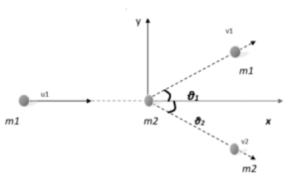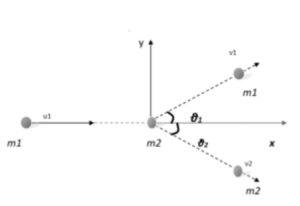Collision is the collision of two or more particles for a brief period of time in which they exert relatively strong forces on each other. Physical contact between two bodies is not required in a collision.
Collision is defined as two things colliding for a very brief period of time. In other terms, a collision is a reciprocal contact between two masses that occurs for a relatively brief period of time and results in changes in the momentum and energy of the colliding masses. You may have noticed the effect of a striker on coins when they collide while playing carroms.
A collision occurs when two masses, m1 and m2, collide. The speed of particle m1 is v1i, where the subscript I denotes the initial. The mass m2 particle is at rest.

The object with mass m1 collides with the stationary object with mass m2 in this situation. CollisionsThe masses m1 and m2 move in opposite directions as a result of the collision.
Types of collision:
In most collisions between two masses, the law of conservation of momentum holds true, but there are rare collisions where Kinetic Energy is not conserved. Depending on the nature of energy conservation, there are two options:
Elastic Collision:
The total momentum, total energy, and total kinetic energy are all conserved in an elastic collision. However, because the forces involved in the short interaction are conserved in nature, the total mechanical energy is not converted into any other energy form. Consider the graph above, which shows two masses, m1 and m2, traveling at speeds of u1 and u2. v1 and v2 are the speeds after these masses collide. The law of conservation of momentum will take care of everything.
m1u1 + m2u2 = m1v1 + m2v2
Inelastic collision:
The objects in an inelastic collision stick together or travel in the same direction. The entire kinetic energy is not conserved in this type of collision, but the total momentum and energy are. The energy is changed into various energy types such as heat and light during this type of collision. Because the two masses follow the law of conservation of momentum and travel in the same direction at the same speed v during the phenomena, we have:
m1u1 + m2u2 = (m1+ m2)v
v= (m1u1 + m2u2)/(m1+ m2)
The Restitution Coefficient:
The coefficient of restitution is the ratio of the relative velocities of colliding masses before and after the impact. The coefficient of restitution, denoted by ‘e,’ is determined by the material of the colliding masses. e = 1 for elastic collisions and e = 0 for inelastic collisions. In all other types of forceful encounters, the value of e > 0 or e 1.
The idea of coefficient of restitution can be applied to collisions involving the planar motion of smooth bodies, including both particles and bigger bodies that must account for rotation effects. Experiments reveal that the velocity components to use for e in these collisions are the components along the common normal to the surfaces of the bodies at the point where they collide. The velocity components perpendicular to this direction are unchanged for smooth bodies. To address two-dimensional collision situations with smooth bodies, this solution and the concept of conservation of momentum are adequate. For smooth sphere collisions, the velocity components to utilize for e are those on the line connecting the spheres’ centres.
One Dimensional Collision:
The collision in which both the starting and ultimate velocities of the masses lie on one line is known as a one-dimensional abrupt interaction of masses. In a single dimension, all motion variables are encapsulated.
Elastic One Dimensional Collision:
Internal kinetic energy and momentum are both conserved in elastic collisions, as previously stated. Elastic collisions can only be achieved with minuscule particles such as electrons, protons, and neutrons.
m1u1+m2u2=m1v1+m1v2
Inelastic One Dimensional Collision:
Colliding masses in an inelastic one-dimensional collision stick together and move in the same direction at the same pace. Kinetic energy is converted into numerous kinds of energy while momentum is conserved. The conservation of momentum equation for inelastic collisions is:
m1u1 + m2u2 = (m1 + m2) v
Collision in Two Dimensions:

The above illustration depicts a two-dimensional collision in which the masses collide and move in opposite directions. The moving mass m1 collides with the stationary mass m2 at this point. In the two-dimensional interaction of masses, linear momentum is conserved. The masses are traveling in x,y planes in this scenario. The following are the x and y component equations:
m1u1=m1u2cos1+m2v2cos2
0=m1u2sin1+m2u2cos2
Collisions between spherical objects with smooth surfaces occur only when the items come into contact. This is how games like marbles, carom, and billiards work.
Conclusion:
When particles, groups of particles, or solid bodies move toward each other and get close enough to interact and exert mutual influence, this is called a collision.
The concept of conservation of momentum asserts that when the only forces acting on colliding bodies are those exerted by the bodies themselves, the total momentum of the system remains unaltered during the collision process.Collisions are classed as elastic or inelastic depending on whether mechanical energy (and consequently kinetic energy) is conserved or not.
The coefficient of restitution determines whether the collision is elastic or inelastic. A perfectly inelastic collision, in which the colliding bodies stick together after the collision, has a coefficient of restitution equal to zero.
 Profile
Profile Settings
Settings Refer your friends
Refer your friends Sign out
Sign out






